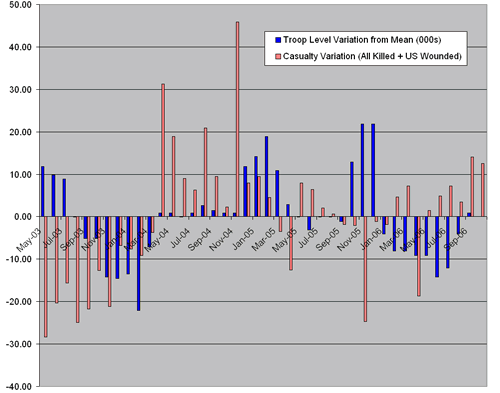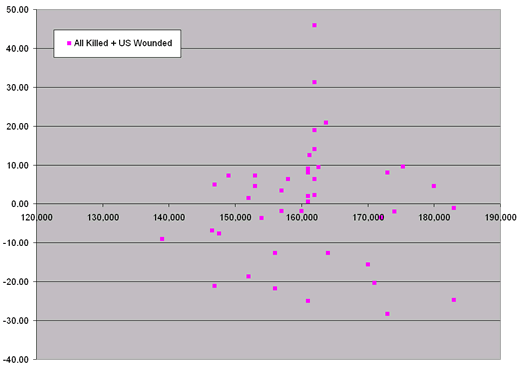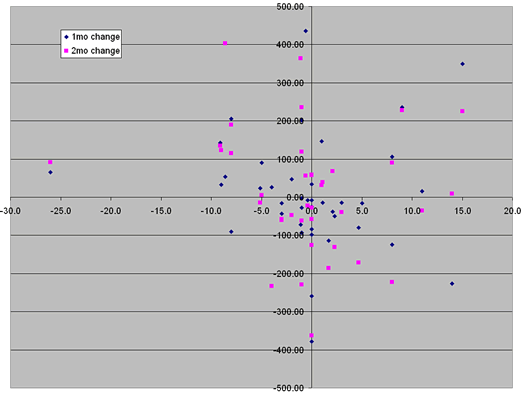November 16, 2006
Iraq casualties part 2: counting in US wounded
Lots of emails today, many with very good points. See the previous entry that they refer to here. If time and available data permits, I'll try and continue this line of inquiry.
One point that a correspondent raised was why not use Coalition wounded and killed, instead of just KIA figures, which is what Stuntz used? There were a couple reasons for this:
1) There's no accurate publicly available measure for non-US coalition WIAs in Iraq: the best one could do would be to count US killed and wounded, plus non-US killed, and assume coalition wounded numbers (which if comparable in proportion would be about 5-10% of the 21,400 US wounded, or 1-2,000 soldiers) did not skew one's numbers too much;
2) US monthly WIA figures include both wounded soldiers who are returned to their units within 72 hours, and those that are evacuated from theatre. This could lead to soldiers in high-intensity environments being counted in the wounded column multiple times.
Still, if one can deal with those caveats, there's no problem providing similar graphs for all KIA casualties plus US wounded in the same format. The chart below shows the variation from the mean in thousands of the Coalition forces (in blue) against variation from the mean in US wounded plus all killed per 10,000 occupiers per month (corrected for seasonal variation), in red. As in the post below, blue bars above the zero-line indicate periods of troop strength. Red lines above the zero-line indicate periods of higher-than-average Coalition casualties. If more troops lead to fewer casualties, and vice versa, red bars up top should be matched by blue bars below, and vice versa:

Looking at this graph, as with the last one, one can see it tells something of a narrative of occupation: in some cases it shows more troops leading to a decrease in Coalition fatalities, and in others not. In late 2003, the degree of violence was on the increase, in a period of relative undermanning, but in 2004 after the First Battle of Fallujah, the anti-Coalition violence was dropping even while troop levels stayed fairly steady, up until the Second Fallujah period in November 2004. That was followed by a 20,000-strong US surge into the theatre, which, it is true, could be interpreted as being simultaneous with a calm on the violence, but then again in mid 2005 one can see violence levels decreasing even though troop levels stayed at a steady state. The second surge at the end of 2005 was too short to have a clearly discernible effect. Most recently, one sees a period where Coalition troop levels are rising again, but violence against them is increasing simultaneously.
The scattergraphs, when US WIAs are counted, don't appear to offer any more of a strong correlation than when just killed were counted. Here is the comparison of casualty levels (y-axis) vs troop levels (x-axis):

Here is the comparison of changes in anti-Coalition violence level (y-axis) vs changes in troop level (x), with one set of points showing the same (1-month) comparison, and the other showing the change in violence levels 2 months after the change in troop levels. The troops = peace thesis, if true, would be represented on this graph as a clear line sloping down left to right through the zero point, with points in the high left and low right quadrants:

It appears that regardless of one uses this new measure of Coalition wounded and killed, or just the KIA number from before, as one's measure of Iraq violence, it is still no more clear-cut whether adding more troops can produce more security, at least based on the Iraq record so far. Another interesting question is whether there is an impact from increases and decreases in troop levels on the violence being done to Iraqis. Obviously this is fraught with problems given the many opinions out there on what the correct way to measure Iraqi casualties is, but it's something I'd still like to examine further.
"endearingly macho" -- Mark Steyn
"wonderfully detailed analysis" -- John Allemang, Globe and Mail
"unusually candid" -- Tom Ricks, Foreignpolicy.com
May 2010
April 2010
March 2010
February 2010
January 2010
December 2009
November 2009
October 2009
September 2009
August 2009
July 2009
News:
The Globe and Mail
The Star
The Wash. Post
Opinion:
TNR
Slate
Washington Monthly
Rants:
Canadians
Penny
Janes
Cosh
The Hound
Coyne
Wells
Farrell, etc.
Steyn
Levant
Afghanistan
The Torch
Abu M.
Bill & Bob
Ghosts of Alex
Registan
Jari
Ink Spots
Ackerman
Kings
FRI
Embedded
Milnews.ca
Can-AFG
The Capt.
Etc.
TMLutas
Sullivan
Marshall
Kaus
Lileks
Reynolds
Welch
Farber
The Shark
Breen
Henley
Electrolite
Samizdata
Slotman
Simberg
Northrup
Bryant
Yglesias
Cole
Drum
Clients/Employers
(Past and Present):
U of T
Cdn. Forces
CG Magazine
LRC
Adrenaline Vault
